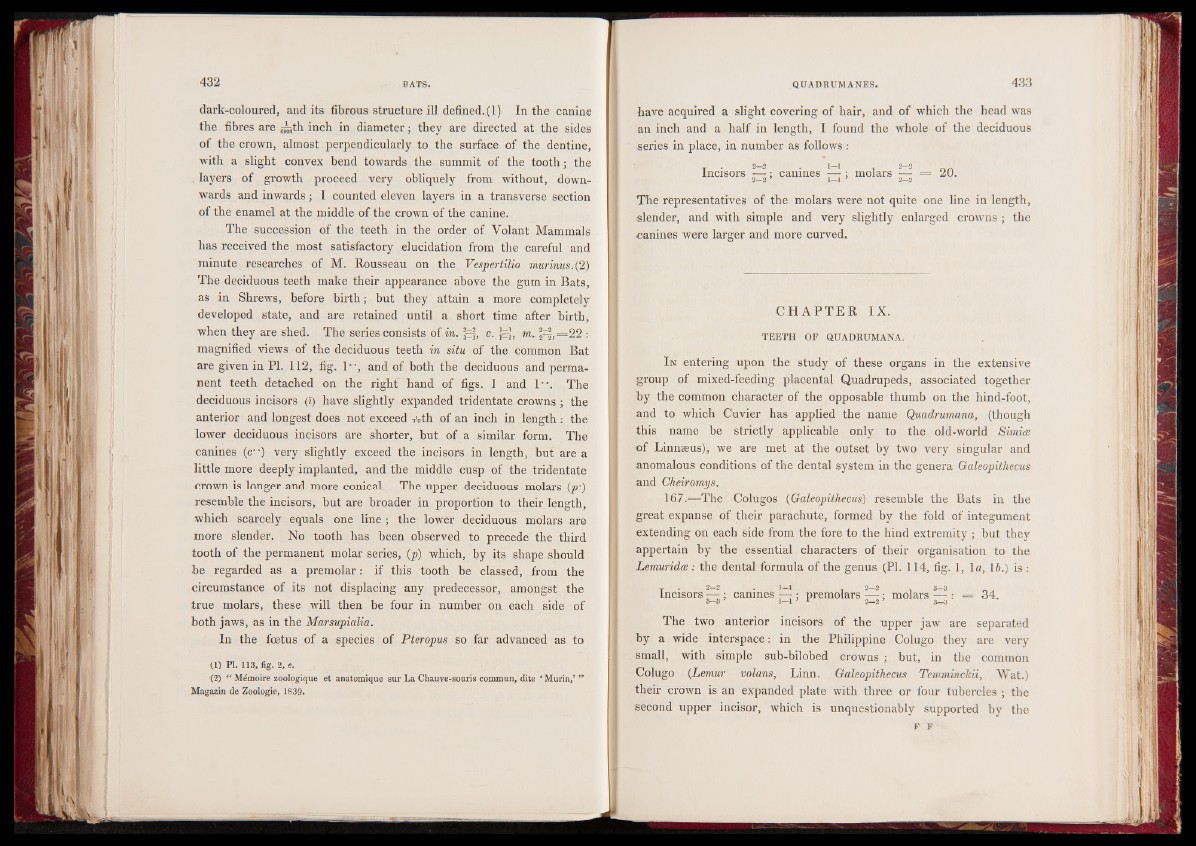
dark-coloured, and its fibrous structure ill defined. (1) In the canine
the fibres are ^ th inch in diameter; they are directed at the sides
of the crown, almost perpendicularly to the surface of the dentine,
with a slight convex bend towards the summit of the tooth; the
. layers of growth proceed very obliquely from without, downwards
and inwards; I counted eleven layers in a transverse section
of the enamel at the middle of the crown of the canine.
The succession of the teeth in the order of Volant Mammals
has received the most satisfactory elucidation from the careful and
minute researches of M. Rousseau on the Vespertilio murinus.(2)
The deciduous teeth make their appearance above the gum in Bats,
as in Shrews, before birth; hut they attain a more completely
developed state, and are retained until a short time after birth,
when they are shed. The series consists of in. §E§, c. jE-J, m. |=§,=22 :
magnified views of the deciduous teeth in situ of the common Bat
are given in PI. 112, fig. 1", and of both the deciduous and permanent
teeth detached on the right hand of figs. 1 and l" . The
deciduous incisors (i) have slightly expanded tridentate crowns ; the
anterior and longest does not exceed -iVth of an inch in length : the
lower deciduous incisors are shorter, but of a similar form. The
canines (r •) very slightly exceed the incisors in length, but are a
little more deeply implanted, and the middle cusp of the tridentate
crown is longer and more conical. The upper deciduous molars (p')
resemble the incisors, but are broader in proportion to their length,
which scarcely equals one line ; the lower deciduous molars are
more slender. No tooth has been observed to precede the third
tooth of the permanent molar series, (p) which, by its shape should
be regarded as a premolar: if this tooth be classed, from the
circumstance of its not displacing any predecessor, amongst the
true molars, these will then he four in number on each side of
both jaws, as in the Marsupialia.
In the foetus of a species of Pteropus so far advanced as to
U) H. 113, fig. 2, e.
(2) Memoire zoologique et anatomique sur La Chauve-souris commun, elite ‘ Murin,’ ”
Magazin de Zoologie, 1839.
have acquired a slight covering of hair, and of which the head was
an inch and a half in length, I found the whole of the deciduous
series in place, in number as follows :
Incisors — ; canines — ; molars — = 20. 2—2 ’ 1—1 2—2
The representatives of the molars were not quite one line in length,
slender, and with simple and very slightly enlarged crowns ; the
canines were larger and more curved.
CH AP T E R IX.
TEETH OF QUADRUMANA.
In entering upon the study of these organs in the extensive
group of mixed-feeding placental Quadrupeds, associated together
by the common character of the opposable thumb on the hind-foot,
and to which Cuvier has applied the name Quadrumana, (though
this name be strictly applicable only to the old-world Simia
of Linnaeus), we are met at the outset by two very singular and
anomalous conditions of the dental system in the genera Galeopithecus
and Cheiromys.
167.—The Colugos (Galeopithecus) resemble the Bats in the
great expanse of their parachute, formed by the fold of integument
extending on each side from the fore to the hind extremity ; hut they
appertain by the essential characters of their organisation to the
Lemuridce: the dental formula of the genus (PI. 114, fig. 1, la, 16.) is :
Incisors — ; canines — I premolars — ; molars — : = 34. 8—3 l—l ’ r 2—2 ’ 3—3
The two anterior incisors of the upper jaw are separated
by a wide interspace: in the Philippine Colugo they are very
small, with simple sub-hilobed crowns ; but, in the common
Colugo (Lemur volans, Linn. Galeopithecus Temminckii, Wat.)
their crown is an expanded plate with three or four tubercles ; the
second upper incisor, which is unquestionably supported by the
F F